Civil justice statistics in Scotland: 2017-2018
The 2017-2018 Civil Justice in Scotland release includes main statistics tables, figures and supplementary statistics tables.
This document is part of a collection
2. Civil justice problems
In this chapter we examine the types of civil legal problems people experience in Scotland, as determined by the Scottish Crime and Justice Survey 2017-18, and what sorts of issues are presented at court.
First we look at information from the representative sample in the Scottish Crime and Justice Survey. We then examine the long-term trends in the courts' data. Finally we look at the changes in legal aid sought in Scotland.
Our findings suggest that:
- According to the Scottish Crime and Justice Survey 2017-18, three in ten adults experienced civil law problems in the three years prior to interview.
- Debt cases made up 46% of primary craves initiated at civil courts in 2017-18. Debt initiations also increased by 22% from 2016-17.
- Evictions made up 18% of primary craves initiated at civil courts in 2017-18.
- Family cases made up 16% of primary craves, of which 75% related to divorce and dissolution in 2017-18.
- Just under 35% of personal injury cases were raised in the national Sheriff Personal Injury Court.
- Over three in four damages cases were initiated under simple procedure in 2017-18. 43% of the simple procedure cases disposed of were dismissed.
- The number of repossession cases initiated rose for the first time in six years in 2017-18 (up 17% from 2016-17).
- In 2017-18, there were 13,093 civil legal aid grants, the vast majority of which were for cases in the sheriff courts.
Figure 1: Case types initiated at civil courts, 2008-09 - 2017-18
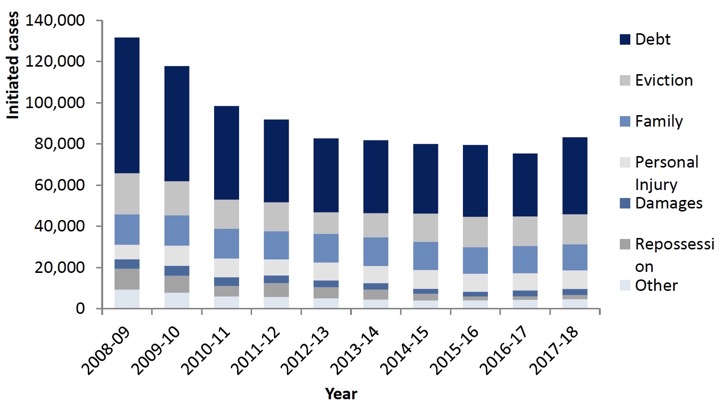
2.1 Scottish Crime and Justice Survey - civil justice module
The Scottish Crime and Justice Survey 2017-18 estimates that three in ten adults experienced civil law problems in the three years prior to interview
The Scottish Crime and Justice Survey (SCJS)[6] includes questions on experience of and response to civil law problems. Respondents are asked if they have experienced one or more of a list of problems or disputes in the three years prior to interview[7]. They are then asked whether they have attempted to solve them.
The problem areas covered are:
- home or family living arrangements
- money, finances or anything paid for
- unfair treatment
- health and well-being
The 2017-18 SCJS shows that around three in ten adults (31%) were estimated to have experienced at least one of the civil law problems asked about in the previous three years. This is similar to both the 29% reported in 2016-17 and 30% reported in the 2008-09 SCJS[8].
Some groups in the population were more likely to experience civil law problems than the general population. For example, an estimated 38% of those who are disabled experienced a civil law problem compared with 28% of those who are not disabled. Those who lived in one of the 15% most deprived areas in Scotland suffered a higher prevalence of civil justice problems (40%) than those who did not (29%), as did victims of crime (45%) compared with non-victims (28%).
Among the problem areas listed above, 21% of adults had experienced problems with home or family living arrangements, 10% had experienced problems with money, finances or anything they had paid for, 8% had been treated unfairly in some respect and 6% had experienced health or well-being problems.
The most common single problem was with neighbours, experienced by 15% of adults. The next most common civil law problems involved faulty goods or services (5%) or money & debt (4%). The full breakdown is shown in Figure 4.
Figure 4: Experience of civil law problems: SCJS 2017-18
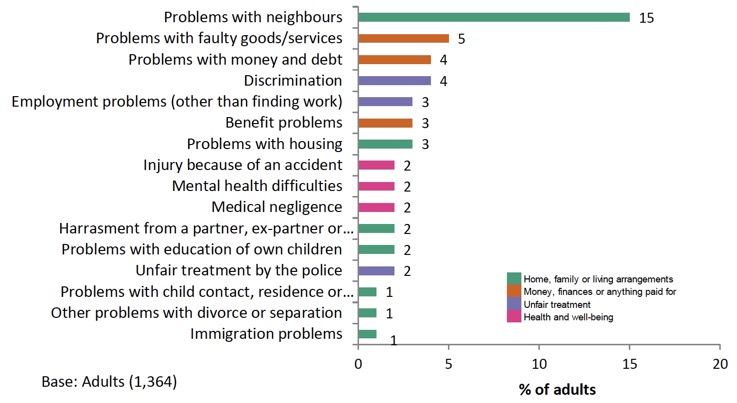
Among those who had experienced civil law problems in the last three years, over a third (35%) said a problem concerning neighbours was their most important or only problem to solve. The next most important problems involved faulty goods or services (8%) or discrimination (8%).
Thirty-one per cent of these problems began less than a year ago, a further 19% over a year but less than two years ago, 17% over two years but less than three years ago and 31% over three years ago.
Just over two fifths (42%) had resolved the problem, while just over a third (34%) were still trying to resolve the problem. One in ten had tried to resolve the problem but had to give up (11%) and a similar proportion (11%) were not planning to do anything.
Scottish Crime and Justice Survey problems which correspond to those commonly handled by the civil courts are summarised in the following sections:
Debt (section 2.2.1) - An estimated 4% of adults in the 2017-18 Scottish Crime and Justice Survey reported having money and debt problems. The prevalence of money and debt issues varied by tenure, for example, owner occupiers were less likely to have experienced such issues in the previous three years (2%) than social tenants (8%).
Family (section 2.2.3) - The 2017-18 SCJS found that an estimated 2% of adults experienced problems to do with the behaviour of a partner, ex-partner or other person harassing them, 1% experienced a problem to do with child contact, residence or maintenance and similarly 1% experienced problems to do with divorce or separation.
Personal injury (section 2.2.4) - The 2017-18 Scottish Crime and Justice Survey found that an estimated 2% of respondents experienced a medical negligence issue and similarly 2% experienced a personal injury problem in the last three years.
2.2 Volumes and types of problems in the courts
In this section we examine the types of civil law problems recorded in court statistics, and any changes in their likelihood over time.
Figure 5: Debt cases remain the most common problem at civil courts
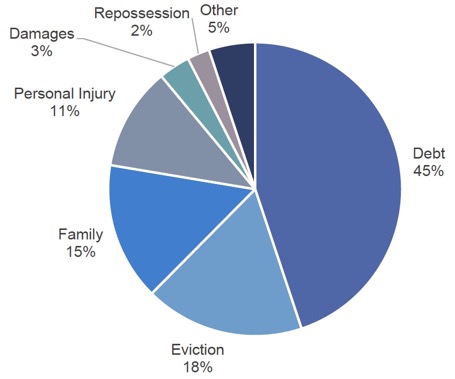
The civil law court statistics presented in this bulletin relate only to the principal crave of cases. An individual case can involve a number of different case types. The case type which is listed first on the writ is normally known as the principal crave and the others are described as ancillary craves. By not including ancillary craves, our statistics will be underestimating those case types recorded under this heading. The feasibility of publishing statistics on ancillary craves in future editions is being investigated in line with the Scottish Government's strategy for justice in Scotland[9].
In 2017-18, debt actions were the most common, constituting 45% of all civil court cases. Eviction and family actions were second and third most common, at 18% and 15% respectively (Figure 5) (percentages include summary applications[10]).
Increases in case numbers were observed across most case types except for family. The largest increases were recorded for Debt (+22%), Repossession (+17%) and Personal Injury (+13%), while Family decreased by 5% (Table 27).
2.2.1 Debt
Debt cases made up 46% of primary craves initiated at civil courts in 2017-18
The number of debt cases increased to 37,364, but has not reached pre-2012 levels
86% of debt cases initiated in 2017-18 were under the new simple procedure
Money owed to an individual or organisation is known as a debt and can include council tax, business taxes, hire purchase agreements, utility bills, bank overdrafts and loans. Where there is a dispute over a debt and a creditor wishes to enforce their right for payment, they can raise a debt case in court.
The Scottish Legal Aid Board, in their fifth monitoring report, found that: "Other routes to debt management or resolution of the debt issue, not involving court, are increasing in importance. Debt management companies and the not-for-profit sector appear therefore to be an increasingly important avenue for people seeking assistance with debt issues than solicitors."
Evidence
Debt actions have consistently been the most common primary craves over the past 10 years.
The number of debt actions fell in line with the overall trend for civil justice court proceedings initiated, though at a slightly faster rate, between 2008-09 and 2012-13.
There was an increase in the number of debt actions as primary craves in 2015-16 compared with 2014-15 (a 3% increase), followed by a large (12%) fall in 2016-17.
In 2017-18, the number of debt actions increased by 22% on the previous year, from 30,567 to 37,364 (Table 11 & Figure 6). This is likely due to a rise in interest from the public following implementation of simple procedure.
Of these 37,364 debt actions initiated, 86% were brought to the sheriff court under the new simple procedure, up from 20% in the previous year. A very small number were small claims or summary cause proceedings. 13% were brought to the Sheriff court under ordinary cause procedure, down from 15% in 2016-17.
Figure 6: Debt cases initiated rose in 2017-18, but not to pre-2012 levels
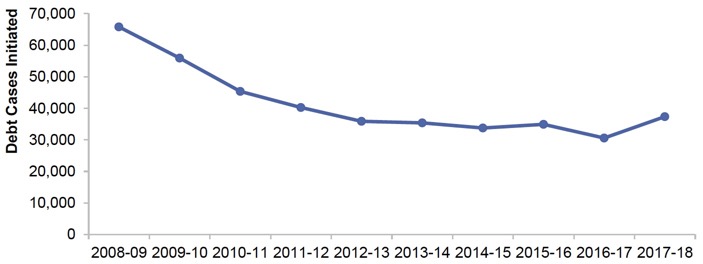
2.2.2 Eviction
Evictions made up 18% of primary craves initiated at civil courts in 2017-18
Evictions initiated increased very slightly, by 2% from the previous year to 14,604 cases
Eviction cases involve the taking of property by the owner from an occupier, usually a tenant. Landlords can apply for an eviction order if they want their tenants removed from the property.
From 1 December 2017, the last quarter of these data, all civil private rented sector eviction cases, including short assured, assured and private residential tenancies are dealt with by the First Tier Tribunal Housing and Property Chamber (criminal cases remain with the sheriff court).
Initiating eviction action for social housing (local authority and registered social landlord) rent arrears cases can only happen after the landlord has followed a set of pre-action requirements. By granting an eviction order, the courts permit the eviction process to proceed, but this does not mean that eviction will necessarily take place.
The eviction statistics in this bulletin relate to tenants of rented properties in social housing (local authority and registered social landlords) and private sector tenants prior to 1 December 2017. Detailed statistics on the eviction of local authority tenants are available from Housing Statistics for Scotland.
Evidence
Between 2008-09 and 2012-13 there was a consistent fall in the number of evictions as primary craves, falling around 47% over that period from around 20,000 to 10,532.
These figures increased in 2013-14 through 2015-16 to 14,690. A small dip in 2016-17 has been followed by a return to 2015-16 levels in 2017-18, when there were 14,604 evictions initiated. Around 60% of eviction cases were found "for pursuer", and 85% of cases were undefended (Table 23).
All evictions are brought as summary cause to the sheriff court.
Figure 7: Eviction case numbers have stabilised for the past three years
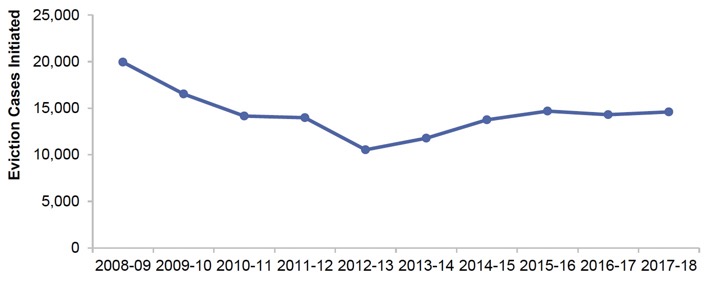
2.2.3 Family
Divorce and dissolution made up 75% of family cases in 2017-18
Nearly all of the 6,873 divorces granted in 2017-18 were heard in sheriff courts, and 61% used the simplified procedure
Family law covers a wide range of areas related to families, couples and children. These include: divorces and dissolutions; applications relating to parental responsibilities and rights; and permanence and adoption cases.
Family law also covers interdicts preventing a party from making specific contact or coming within close proximity to another, and exclusion orders that suspend the rights of an individual to live in the family home.
This section also contains statistics on sheriff court summary applications relating to adoption and children's hearings.
The courts statistics presented in this bulletin relate only to the principal crave of the case. This means that the statistics on certain case types, such as contact and residence, do not reflect the true number of actions brought to court as these issues are often ancillary craves in a case where the principal crave is for divorce. The feasibility of publishing statistics on ancillary craves in future editions of this bulletin is being investigated.
Family law evidence summary
There has been a general downward trend in the number of family actions as primary craves since 2008-09. There was a 15% fall from 14,836 in 2008-09 to 12,652 in 2017-18 (Table 5). Family is also the only case type to see a decrease in initiations in the last year (5% or 600 cases).
There have been no evident changes in distribution of types of case or the courts used.
Figure 8: Family cases initiated in the civil courts, 2017-18
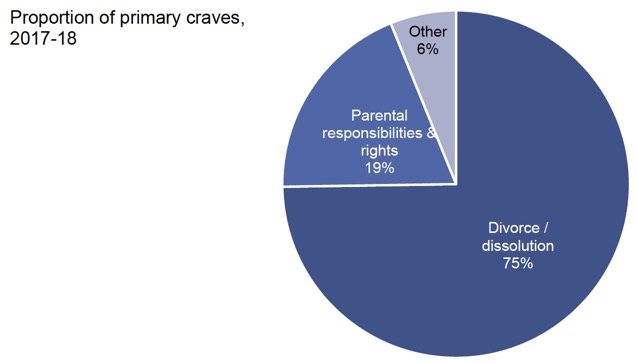
Divorce / dissolution and parental responsibilities and rights are the biggest case types and together account for 94% of family cases initiated.
Only a small proportion of family cases are heard in the Court of Session (87 or 1% in 2017-18), representing 9% of cases in the General Department of that court (Table 2 & Table 6). Of these 87 cases, Divorces and dissolutions accounted for 89%.
In 2017-18, the vast majority (89%) of applications to extend/vary an interim order disposed of were granted. Similarly, most children's hearings (referral applications) were granted and established the grounds for referral, with the case being referred back to the Children's Hearing to dispose of the case (Table 8).
The number of adoption petitions has been relatively stable in recent years. In 2017-18 there were 533 such cases initiated. The number of applications initiated for permanence orders with authority to adopt decreased slightly, down 5%, to 388 in 2017-18.
Divorce and dissolutions statistics
Divorce is the formal procedure that ends a marriage, while the procedure for ending civil partnerships is known as dissolution. In addition to divorce and dissolution, the courts can also take decisions on where a child should live when parents separate; whether the non-resident parent should have contact with the child and who should have parental responsibilities and rights. Where children are involved, or there is a claim for financial provision, the ordinary procedure is used. However, the majority of divorces and dissolutions use a simplified procedure which is low-cost and simpler.
The divorce and dissolution statistics presented in Table 9 and Table 10 are based on different Scottish Courts and Tribunals Service data from the other statistics in this bulletin. See the section 3.6 for more information.
Further statistics, broken down by characteristics such as age at marriage/partnership, age at divorce/dissolution, duration and form of marriage/partnership, are available on the Civil Justice Statistics in Scotland datasets website within the Divorces & Dissolutions Supplementary Tables. However, at the time of publishing this bulletin, we do not have the detailed divorce and dissolutions data to update the supplementary tables with 2017-18 figures.
Divorce and dissolution of a civil partnership
The Civil Partnership Act 2004 came into force on 5 December 2005, allowing legal relationships between two people of the same sex to be formed. The first civil partnerships in Scotland were registered on 20 December 2005.
On 12 March 2014, The Marriage and Civil Partnership (Scotland) Act 2014 received Royal Assent. Following this Act, the first same-sex marriage ceremonies took place in Scotland on 31 December 2014. In addition, couples in civil partnerships are able to change their relationship into a marriage.
The latest data on marriages and civil partnerships registered can be found in the Marriages and Civil Partnerships section of the National Records of Scotland website.
Divorce & dissolution evidence
The number of divorces has been slowly decreasing from around 13,400 in 1985 to 6,800 in 2017 (Figure 9)[11]. The main exception to this trend was a sharp rise in divorces in 2006. This rise can be attributed to the reduction in non-cohabitation periods required to prove irretrievable breakdown of a marriage brought into force by the Family Law (Scotland) Act 2006.
The total number of divorces granted in Scotland in 2017-18 was 6,873, 13% fewer than in 2016-17 (7,938) (Table 9). In 2017-18, 61% of divorces granted used the simplified procedure.
There were 61 civil partnership dissolutions granted in 2017-18, down from 83 in 2016-17 (Table 10). The vast majority of dissolutions granted in 2017-18 (92%) used the simplified procedure.
Figure 9: Downward trend of divorces since 1985
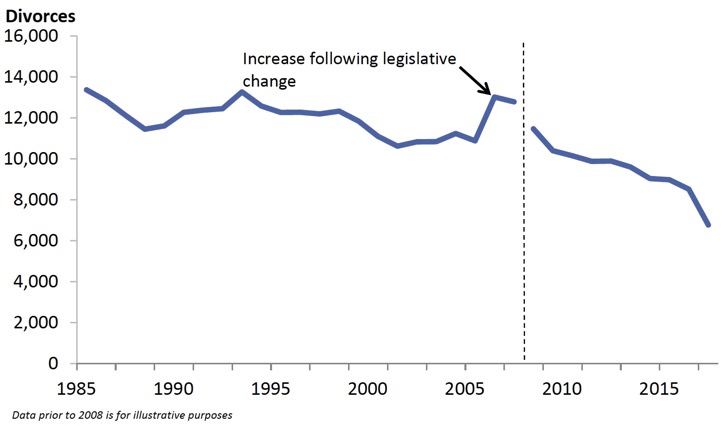
2.2.4 Personal injury
There was a 13% increase in personal injury cases initiated in 2017-18 compared to 2016-17
Just under 35% of personal injury cases were raised in the national Sheriff Personal Injury Court
Nearly three in five personal injury cases were in relation to road traffic accidents
Personal injury can be physical and/or psychological, and include disease or impairment. Personal injuries may result from a wide range of causes including an injury received at work, a traffic accident, or through negligence or a deliberate act on the part of another party. A person who has suffered an injury can seek redress through several routes, such as making a complaint against the person/organisation they consider to be responsible for the injury, seeking assistance with any financial problems they have as a result of their injury, or seeking counselling. Alternatively, they may wish to claim compensation, provided certain criteria are met to cover losses they have suffered as a result of the injury.
A personal injury case is a form of damages case that relates specifically to damages for, or arising from, personal injuries or the death of a person from personal injuries. Other cases, for example defamation, are covered under damages in section 2.2.5.
Evidence
Since 2009-10 there has been between 7,500 and 10,000 personal injury cases initiated as primary craves each year. There were 9,443 in 2017-18 - the highest level since 2010-11 (Table 13). However since there has been a high degree of variation over this period, this apparent change is within the bounds of expectation and not necessarily an indication of longer-term change.
Figure 10: Road traffic and clinical negligence cases have increased since 2016-17
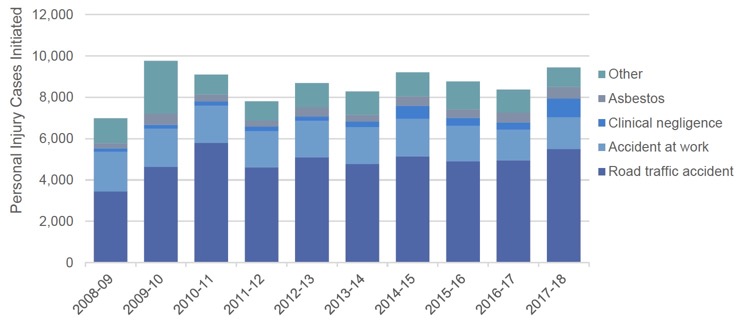
The prevalence of personal injury cases as a proportion of all primary craves is up 1% from 2016-17, at 12%.
There has not been a large change in the procedures used to hear personal injury cases since 2016-17. Around one third are brought to the sheriff courts as summary cause, and a further third to the Sheriff Personal Injury Court. A quarter are brought under ordinary cause to the sheriff courts, and 5% to the Court of Session.
However, in some specific cases there are differences in how different types of Personal Injury are using procedures in the courts, as shown in Figure 11.
The Sheriff Personal Injury Court is increasingly likely to cover accidents at work and Asbestos-related cases, with over 80% of these cases using the new court.
The majority of additional asbestos cases in 2017-18 (up 98 to 568) were initiated at the Sheriff Personal Injury Court. 80% of asbestos related cases were raised at this court, around the same proportion as in the previous year (79%) (Table 17).
There has been a small increase in accident at work cases since the previous year (up 67 to 1,547). A larger proportion of these were brought to the Sheriff Personal Injury Court, increasing from 77% to 82%.
There has been a large increase in the number of clinical negligence cases initiated since 2016-17, from 351 to 901 in 2017-18. Edinburgh Sheriff Court experienced an unusually high volume of summary cause clinical negligence initiations in 2017-18 (Table 16). Excluding these cases, the volume of business from clinical negligence would show a decrease from the previous year and division of business would be unchanged.
Figure 11: Accidents at work and asbestos cases most likely use the new Sheriff Personal Injury Court
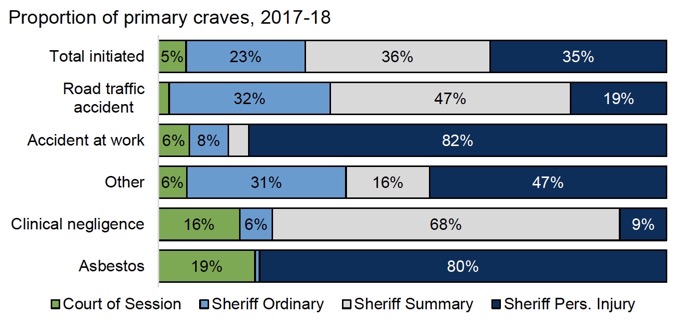
2.2.5 Damages
The number of damages cases rose by 3% from 2016-17
Over three in four damages cases were initiated under simple procedure in 2017-18. 43% of the simple procedure cases disposed of were dismissed.
Around three in four damages cases disposed of in the Court of Session had a decree of absolvitor
Damages are a legal remedy that provide compensation for harmful actions suffered through the fault of another party, either an individual or an organisation. A claim for damages can arise from all sorts of circumstances and include (but is not limited to): defamation, breach of contract, damage to moveable property, negligence, breach of warranty or guarantee, breach of trust, wrongful diligence, wrongful interdict, malicious prosecution, wrongful apprehension or false imprisonment or fraudulent representation and personal injury. For the purpose of these statistics, the definition for damages does not include personal injuries, which are covered separately in section 2.2.4.
The purpose of a damages case is to provide a remedy by measuring, in financial terms, the harm suffered to restore an injured party, as far as practicable, to the position they were in beforehand. The court has responsibility for assessing the damage and agreeing or modifying the damages proposed by the pursuer as it sees fit.
Evidence
Between 2009-10 and 2015-16 there was a steady fall in the number of damages claims initiated as primary craves. Between 2015-16 and 2016-17 there was a 22% increase from the low of 2,296 to 2,810.
In 2017-18 there was a further, but much smaller, increase of 3% to 2,883 (Table 18).
Of the 2,883 damages actions initiated, just over 75% were brought to the sheriff court under the new Simple Procedure, up from 19% in the previous year. A very small number were under summary cause proceedings. 19% were brought to the sheriff court under ordinary cause procedures, down from 23% in 2016-17 (Figure 12).
Figure 12: Damages cases show broad uptake of simple procedure
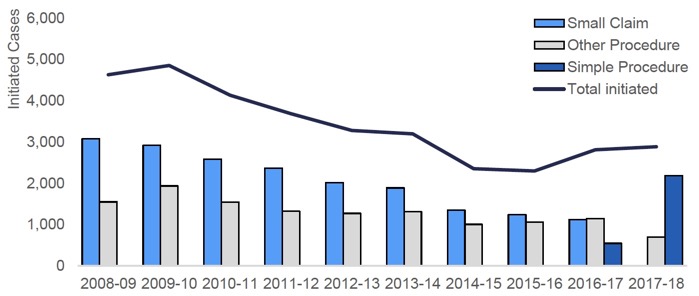
2.2.6 Repossession
The number of repossession cases initiated rose for the first time in six years in 2017-18 (up 17% compared to 2016-17, but down 80% compared to 2008-09)
Repossession involves the retaking of property when a borrower is in breach or default of a mortgage or loan secured on the property. Repossession should not be confused with eviction which, for the purposes of these statistics, refers to the removal of tenants from a rented property (see section 2.2.2).
Historically, repossession cases relating to mortgages and loans were dealt with under ordinary cause procedure. However, the introduction of the Home Owner and Debtor Protection (Scotland) Act 2010 on 30 September 2010 led to these cases being raised instead as summary applications. Where a repossession case relates to non-residential land or property, the action may be raised either as a summary application or as an ordinary action. If successful, the pursuer has the right to take possession of the property.
Evidence
Between 2008-09 and 2010-11 the number of repossessions fell by nearly 50% (from 10,141 to 5,224). However, in 2011-12 we saw an increase of 29% (to 6,752) (Table 20). The low volume in 2010-11 coincides with the introduction of the 2010 Act referenced above and the transition to new procedures.
Between 2011-12 and 2016-17, there were consistent annual decreases in the number of repossessions. From the low of 1,753, there was an increase of around 300 in 2017-18 (17% increase) to 2,056.
In 2017-18, all repossessions were brought as summary applications to the Sheriff court, with none filed under ordinary cause for the first time.
Figure 13: Repossession cases by procedure
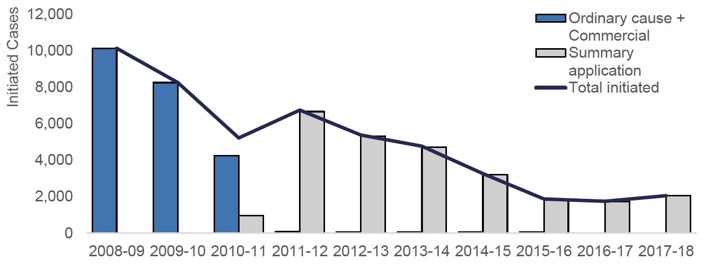
In 2017-18, 65% of repossession summary applications were granted (Table 21). It is important to note that the granting of a repossession case means the court has permitted repossession to take place, but the order may ultimately not be enforced.
2.3 Civil legal aid
In 2017-18, there were 13,093 civil legal aid grants, the vast majority of which were for cases in the sheriff courts
The Scottish Legal Aid Board (SLAB) administers legal aid, which is paid for out of public funds and helps towards the costs of legal advice and representation for those who qualify. It is designed to help individuals who would be unable to pay on their own to gain access to the legal system.
There are two main types of civil legal assistance: advice and assistance (including assistance by way of representation) and civil legal aid. Advice and assistance helps pay for advice from a solicitor on any matter of Scots law. Civil legal aid helps pay for a solicitor to take the case to court.
Evidence
Civil legal aid made up 17% of all grants of total cost of legal assistance.
Demand for and expenditure on civil legal aid has decreased in recent years. Figure 14 shows that the number of applications peaked in 2009-10. Demand then fell overall until 2014-15 when it stabilised for the next two years until this latest year when it fell again.
In 2017-18, there were 13,093 civil legal aid grants, the vast majority of which were for cases in the sheriff courts (Table 28). After steadily rising for over 10 years, legal aid grants in relation to intervention orders and guardianship orders under Part 6 of the Adults with Incapacity (Scotland) Act 2000 now represent the largest category of legal aid certificates issued, at 35% of all grants. The next largest category is contact/parentage, which accounted for 20% of all grants in 2017-18.
Figure 14: Civil legal aid applications and grants follow a similar trend [12]
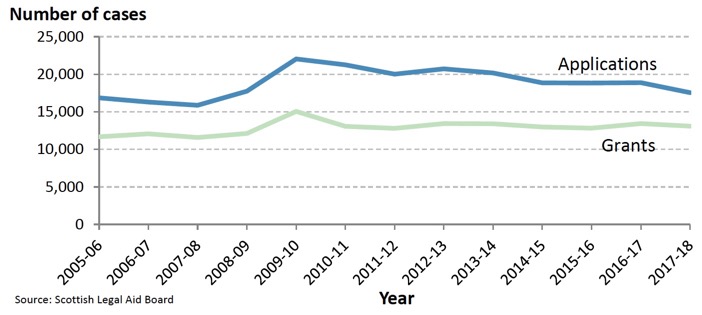
SLAB manages three grant funded programmes for projects across Scotland to enable support for people affected by repossession, eviction, debt problems and benefits disputes. In 2017-18 these programmes enabled 17,224 new clients to access help, including representation at court or tribunal on 6,469 occasions.
Further information and data on legal aid is available from the Scottish Legal Aid Board Annual Report 2017-18.
Contact
Email: justice_analysts@gov.scot
There is a problem
Thanks for your feedback